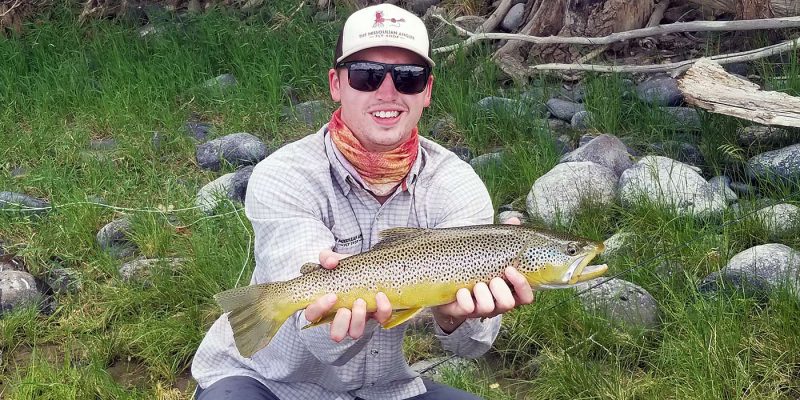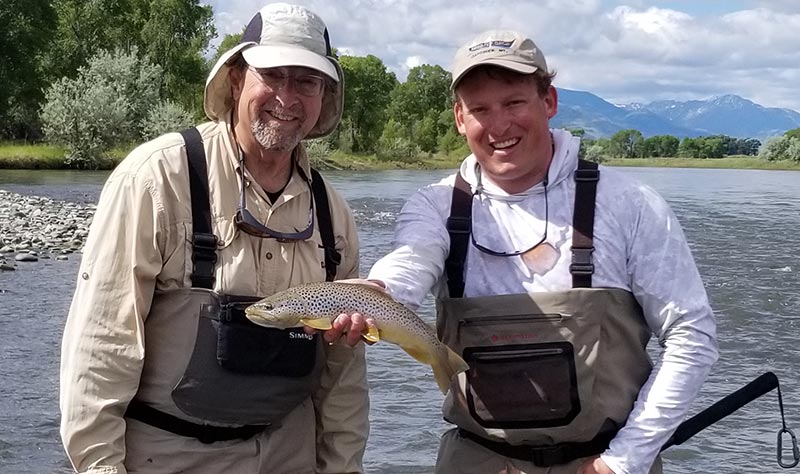Early Summer Float Trips
Posted on January 27th, 2021
Early Summer Float Trips: Introduction and Quick Facts
Between the middle of June and early July, runoff recedes and the high season begins. The next month or so finds rivers still running high and fast, but clear. Insect hatches are abundant, including the famous Salmonfly, and the trout are eager to eat after a month or more of high, muddy water.
This time of year typically offers the best caddis, stonefly, and attractor dry fly fishing of the season, especially for experienced clients able to hit small targets along the bank while the boat is jetting downriver in the high flows. This period is also a decent time for big fish on floats, especially for clients interested in fishing big nymphs and streamers.
Since the fishing and weather and water conditions are great at this time, it’s little wonder that this is the absolute peak season for float fishing in the region.

Early summer is an excellent time to target larger brown trout on big nymphs and dead-drifted streamer flies.
- Best Waters: The Yellowstone, Boulder, and Stillwater are our favorite float rivers at this time, and with these “prime” fisheries nearby all on fire, we seldom run float trips elsewhere at this time.
- Three Top Reasons to Come in Early Summer: 1.) This is peak dry fly time on all rivers, 2.) This time of year offers the most consistent float fishing, if not always the best fishing, and 3.) this period offers the most consistent weather and water conditions of the year.
- Three Top Reasons to Avoid Early Summer: 1.) This is the most crowded time of year, 2.) The fishing is very fast-paced and requires accurate casting, which may be a plus or a minus depending on perspective, and 3.) Late summer and early fall are better for large fish on dry flies, though early summer is better on subsurface flies.
- Perfect Clients: Clients with at least some fly fishing experience who enjoy fast-paced fishing and like to rack up the numbers rather than try to sight-fish or otherwise “hunt” a few big fish (though a few big fish are possible in early summer). Really, early summer is great for all clients except those who want a lazy day and those who can’t stand to see any other anglers on the water.
- What Early Summer Does Best: Early summer provides the best attractor, caddis, and stonefly dry fly and dry-dropper fishing of the season; it’s also a good time for big trout using a few techniques and in a few places, though not generally on dries.
Float Trips in Late Spring
Posted on January 26th, 2021
Late Spring Float Trips: Introduction
Late spring, here meaning from the beginning of the heavy spring melt in the first or second week of May through its conclusion in late June or early July, is prime time for trout fishing in many parts of the United States. In the Rockies, it’s not. This is particularly true for anglers who want to float free-flowing rivers like the Yellowstone, Boulder, and Stillwater rather than those right below dams, like the Lower Madison and Missouri.
The issue is the spring melt that raises all area rivers and turns most into raging brown chocolate milkshakes for at least a few weeks. During this timeframe, river float trips turn to tailwaters: the Madison and Missouri Rivers. These rivers downstream of dams stay clear. Therefore all that the high water they experience does is flush lots of insects and other foods into the drift for the trout to gorge on. In contrast to other rivers, tailwater rivers offer great float fishing at this time.
There’s one other factor that can influence fishing in late spring: runoff breaks. Runoff breaks are periods of cool or cold and usually dry weather that pause the spring runoff for a day or two at a time on freestone rivers, particularly the Yellowstone upstream from Livingston and the Boulder.
When a runoff break occurs, the trout in freestone rivers go bananas, feeding heavily on stonefly nymphs and streamers. If you happen to be here in May or the first three weeks of June when flows are dropping and water clarity is 18 inches or more, fishing on freestones can be better than it is almost any other time of year. You just can’t plan for these breaks, because they’re utterly dependent on day-to-day weather.

This brown came on the Yellowstone River during a runoff break around June 20, 2019, right before the river blew out again. The Yellowstone did not drop into fishable shape for good until July 7 that year.
Other good guided trip options this time of year are our power boat trips and private lake trips. As a matter of fact, this is the one period when these alternative trips are definitely better choices than float trips if you want to fish from a boat. That said, for many anglers nothing can compete with drifting down a river on a boat propelled by oars. Read on for info on where and how we do it through most of May and June.
Test Post
Posted on January 26th, 2021
By far my favorite river to guide in early spring is the Yellowstone. It is clear most of the time in this period, though warm weather can muddy it for a day or two as low-elevation snow melts, especially when the warm weather is accompanied by rain. When this occurs, the lower Madison is a great option. Further afield, the Missouri below Holter Dam is always great in early spring, and sees less traffic at this time than it does a few weeks later.
The major downside of early spring is the weather. “Spring” in Montana is not like spring in warmer places. It might be 15 degrees in the morning. It might snow all day. Worse, it might spit a mix of drizzle and snow. The wind often howls. It might also be 80 degrees and turn the rivers filthy with early snowmelt down from the mountains. Floating can therefore be rather uncomfortable when the weather is bad, and it can be unproductive when it’s “good.” The somewhat variable water and weather conditions carry over to the fishing: it’s not consistent. Sometimes it’s great, but it can be tough too, especially if you’re after big numbers of fish rather than larger fish.
During early spring, half-day trips are better choices most of the time. This is especially true in March. Later in April, and especially in the few days of May before the runoff hits, the water warms and the fish get more aggressive, meaning full days are also a great option. Regardless of trip duration, we won’t meet early. There’s seldom any need to be on the water before 10:00AM.